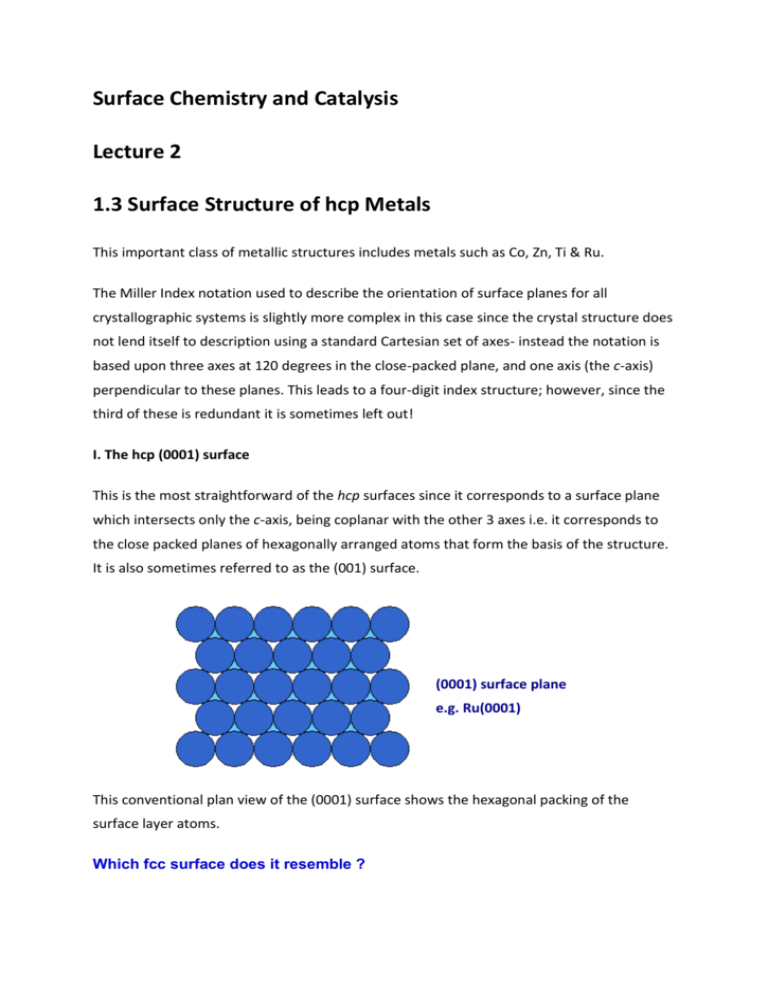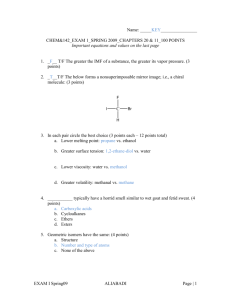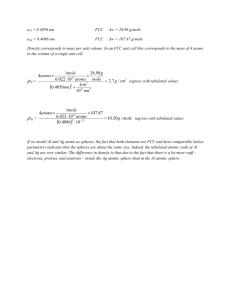pubdoc_10_31718_250
advertisement

Surface Chemistry and Catalysis Lecture 2 1.3 Surface Structure of hcp Metals This important class of metallic structures includes metals such as Co, Zn, Ti & Ru. The Miller Index notation used to describe the orientation of surface planes for all crystallographic systems is slightly more complex in this case since the crystal structure does not lend itself to description using a standard Cartesian set of axes- instead the notation is based upon three axes at 120 degrees in the close-packed plane, and one axis (the c-axis) perpendicular to these planes. This leads to a four-digit index structure; however, since the third of these is redundant it is sometimes left out! I. The hcp (0001) surface This is the most straightforward of the hcp surfaces since it corresponds to a surface plane which intersects only the c-axis, being coplanar with the other 3 axes i.e. it corresponds to the close packed planes of hexagonally arranged atoms that form the basis of the structure. It is also sometimes referred to as the (001) surface. (0001) surface plane e.g. Ru(0001) This conventional plan view of the (0001) surface shows the hexagonal packing of the surface layer atoms. Which fcc surface does it resemble ? We can summarize the characteristics of this surface by noting that: 1. All the surface atoms are equivalent and have CN=9 2. The surface is almost smooth at the atomic scale 3. The surface offers the following adsorption sites : o On-top sites o Bridging sites, between two atoms o Hollow sites, between three atoms 1.4 Surface Structure of bcc Metals A number of important metals (e.g. Fe, W, Mo) have the bcc structure. As a result of the low packing density of the bulk structure, the surfaces also tend to be of a rather open nature with surface atoms often exhibiting rather low coordination numbers. I. The bcc (100) surface The (100) surface is obtained by cutting the metal parallel to the front surface of the bcc cubic unit cell - this exposes a relatively open surface with an atomic arrangement of 4-fold symmetry. bcc unit cell (100) face The diagram below shows a plan view of this (100) surface - the atoms of the second layer (shown on left) are clearly visible, although probably inaccessible to any gas phase molecules. bcc(100) surface plane e.g. Fe(100) What is the coordination number of the surface layer atoms on the bcc(100) surface? Is the coordination of the second layer atoms the same as that of bulk atoms ? II. The bcc (110) surface The (110) surface is obtained by cutting the metal in a manner that intersects the x and y axes but creates a surface parallel to the z-axis - this exposes a surface which has a higher atom density than the (100) surface. bcc unit cell (110) face The following diagram shows a plan view of the (110) surface - the atoms in the surface layer strictly form an array of rectangular symmetry, but the surface layer coordination of an individual atom is quite close to hexagonal. bcc(110) surface plane e.g. Fe(110) What is the coordination number of the surface layer atoms on the bcc(110) surface? III. The bcc (111) surface The (111) surface of bcc metals is similar to the (111) face of fcc metals only in that it exhibits a surface atomic arrangement exhibiting 3-fold symmetry - in other respects it is very different. Top View : bcc(111) surface plane e.g. Fe(111) In particular it is a very much more open surface with atoms in both the second and third layers clearly visible when the surface is viewed from above. This open structure is also clearly evident when the surface is viewed in cross-section as shown in the diagram below in which atoms of the various layers have been annotated. Side View : bcc(111) surface plane e.g. Fe(111) 1.5 Energetics of Solid Surfaces All surfaces are energetically unfavorable in that they have a positive free energy of formation. A simple rationalization for why this must be the case comes from considering the formation of new surfaces by cleavage of a solid and recognizing that bonds have to be broken between atoms on either side of the cleavage plane in order to split the solid and create the surfaces. Breaking bonds requires work to be done on the system, so the surface free energy (surface tension) contribution to the total free energy of a system must therefore be positive. The unfavorable contribution to the total free energy may, however, be minimized in several ways : 1. By reducing the amount of surface area exposed 2. By predominantly exposing surface planes which have a low surface free energy 3. By altering the local surface atomic geometry in a way which reduces the surface free energy The first and last points are considered elsewhere ( 1.7 Particulate Metals, & 1.6 Relaxation and Reconstruction , respectively ) - only the second point will be considered further here. Of course, systems already possessing a high surface energy (as a result of the preparation method) will not always readily interconvert to a lower energy state at low temperatures due to the kinetic barriers associated with the restructuring - such systems (e.g. highly dispersed materials such as those in colloidal suspensions or supported metal catalysts) are thus "metastable". It should also be noted that there is a direct correspondence between the concepts of "surface stability" and "surface free energy" i.e. surfaces of low surface free energy will be more stable and vice versa. One rule of thumb, is that the most stable solid surfaces are those with : 1. a high surface atom density 2. surface atoms of high coordination number (Note - the two factors are obviously not independent, but are inevitably strongly correlated). Consequently, for example, if we consider the individual surface planes of an fcc metal, then we would expect the stability to decrease in the order fcc (111) > fcc (100) > fcc (110) 1.6 Relaxation & Reconstruction of Surfaces The phenomena of relaxation and reconstruction involve rearrangements of surface ( and near surface ) atoms, this process being driven by the energetics of the system i.e. the desire to reduce the surface free energy ( see 1.5 Energetics of Surfaces ). As with all processes, there may be kinetic limitations which prevent or hinder these rearrangements at low temperatures. Both processes may occur with clean surfaces in ultrahigh vacuum, but it must be remembered that adsorption of species onto the surface may enhance, alter or even reverse the process ! I. Relaxation Relaxation is a small and subtle rearrangement of the surface layers which may nevertheless be significant energetically, and seems to be commonplace for metal surfaces. It involves adjustments in the layer spacings perpendicular to the surface , there is no change either in the periodicity parallel to the surface or to the symmetry of the surface. Unrelaxed Surface Relaxed Surface (d1-2 < dbulk ) The lower picture shows the relaxed surface : the first layer of atoms is typically drawn in slightly towards the second layer (i.e. d1-2 < dbulk ) We can consider what might be the driving force for this process at the atomic level .... If we use a localised model for the bonding in the solid then it is clear that an atom in the bulk is acted upon by a balanced, symmetrical set of forces. On the other hand, an atom at the unrelaxed surface suffers from an imbalance of forces and the surface layer of atoms may therefore be pulled in towards the second layer. (Whether this is a reasonable model for bonding in a metal is open to question !) The magnitude of the contraction in the first layer spacing is generally small ( < 10 % )compensating adjustments to other layer spacings may extend several layers into the solid. II. Reconstruction The reconstruction of surfaces is a much more readily observable effect, involving larger (yet still atomic scale) displacements of the surface atoms. It occurs with many of the less stable metal surfaces (e.g. it is frequently observed on fcc(110) surfaces), but is much more prevalent on semiconductor surfaces. Unlike relaxation, the phenomenon of reconstruction involves a change in the periodicity of the surface structure - the diagram below shows a surface, viewed from the side, which corresponds to an unreconstructed termination of the bulk structure. This may be contrasted with the following picture which shows a schematic of a reconstructed surface - this particular example is similar to the "missing row model" proposed for the structure of a number of reconstructed (110) fcc metal surfaces. Since reconstruction involves a change in the periodicity of the surface and in some cases also a change in surface symmetry, it is readily detected using surface diffraction techniques (e.g. LEED & RHEED ). The overall driving force for reconstruction is once again the minimization of the surface free energy - at the atomic level, however, it is not always clear why the reconstruction should reduce the surface free energy. For some metallic surfaces, it may be that the change in periodicity of the surface induces a splitting in surface-localized bands of energy levels and that this can lead to a lowering of the total electronic energy when the band is initially only partly full. Summary The minimization of surface energy means that even single crystal surfaces will not exhibit the ideal geometry of atoms to be expected by truncating the bulk structure of the solid parallel to a particular plane. The differences between the real structure of the clean surface and the ideal structure may be imperceptibly small (e.g. a very slight surface relaxation ) or much more marked and involving a change in the surface periodicity in one or more of the main symmetry directions ( surface reconstruction).







